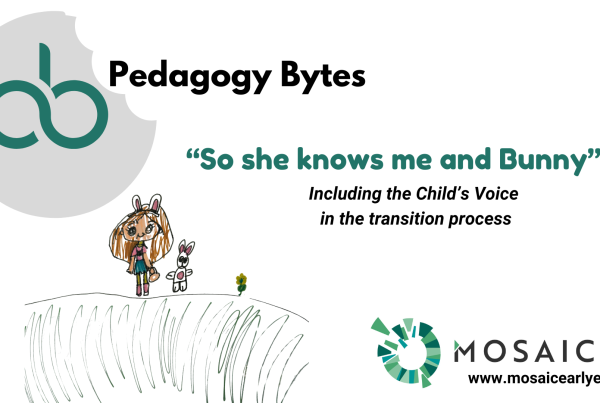Some children are naturally shy. This means they take longer to warm up or are uncomfortable in social situations. Parents and Educators can help a shy child by supporting him/her in social situations and encouraging more confident social behaviour.
In this interesting Meantóir Knowledge Byte, the characteristics of a shy child are outlined, practical tips on how to support shy children to become more socially confident are provided along with some indicators of other possible reasons for a child’s behaviour. The piece finishes with a list of books that you can source to introduce the topic at story time either at home or in the early childhood service.
1. Shy behaviour is normal in babies and children
A baby might cling to her parents, cry in social situations, or physically try to avoid social interaction by hiding her head, moving or turning away, or shutting her eyes.
A pre-school child might not want to talk when unfamiliar people speak to him. He might hide behind a parent, or avoid joining in games.
A school-age child might avoid answering questions in class, have trouble making friends, prefer one or two close friendships, prefer to sit back and watch others play, or avoid new activities.
2. There’s nothing wrong with shyness
All children are different, and some children are more shy than others. It’s just part of their temperament, which is the unique way they interact with the world. Even as an adult, this child will most likely be comfortable in her own company and have a small but close circle of friends.
Naturally shy children need help defining who they are and that they are capable. It is very reassuring for a shy child to have a parent or educator say “you need time to get used to a new situation, and that’s okay. When you’re ready you will sit with the other children, just take your time.”
Do not label a child as shy. Labelling a child as ‘shy’ can make her feel there’s something wrong with her, this is simply who she is.
3. Supporting a child with shyness
Shyness doesn’t always go away over time, but children can learn to be more confident and comfortable interacting with other people. These tips can help.
Tips for babies and young children
• Give a baby time to feel comfortable in new situations. Don’t make him go straight into the arms of an unfamiliar adult. Instead, position yourself and play with a toy near the child and use a calm voice.
• Stay with the child in new social situations, while encouraging her to explore. As a child gets more comfortable the adult can gradually move away for short periods.
• Let a child know that his feelings are OK and that you’ll help him manage them. For example, ‘I can see you feel a bit scared because you don’t know who’s in the room. Let’s look together before we walk in’.
• Avoid over-comforting a child. Over-comforting sends the message that you think this is a scary situation. And the extra attention might accidentally encourage your child’s shy behaviour.
• Following any social gesture, quietly reinforce the child. Behaviour like responding to others, using eye contact, trying something new or playing away from an adult are everyday opportunities to offer quiet reinforcement. Be specific about what he has done.
• Giving positive attention to small social gestures go a long way to show the shy child that behaving in a social manner is not only possible – but can be enjoyable and less pressure-filled than she may have previously thought.
• Try to model confident social behaviour so a child can watch and learn from you.
• If other people say a child is ‘shy’, gently correct them in front of your child. For example, ‘Lou takes a little while to warm up. Once she’s comfortable she’ll be happy to play’. This sends the message that you understand how your child feels, and she can deal with the situation when she’s ready.
4. Tips for Parents
• Encourage playdates, either at your house or a friend’s house. If your child is invited to a friend’s house, he might feel more comfortable if you go with him at first. You could gradually reduce the time you spend with him at other people’s houses.
• Practice show-and-tell or class presentations with your child at home. This will help your child feel more comfortable when she has to stand up in front of her class.
• Encourage your child to do some extracurricular activities. Try to find ones that encourage social behaviour – for example, team sports
• Coach your child before social gatherings – for example, ‘People are going to want to talk with you today. Remember to look at Uncle Dan when he’s talking. If you don’t, he might think you’re not listening to him’.
• Avoid negative comparisons with more confident siblings or friends.
• Help to build your child’s self-esteem by encouraging even small steps towards being less shy.
5. Shyness or something else?
It’s a good idea to talk to a professional to consider other possible reasons for your child’s behaviour. For example:
• A child with a language delay might show signs that she wants to speak to people – for example, looking for eye contact or trying to make social connections – but get frustrated that she can’t be understood.
• A child with a hearing impairment might not hear or respond to what people are saying, or have trouble following instructions.
• A child with autism spectrum disorder (ASD) might have difficulty reading social cues, might not play in the same way as other children and might seem uninterested in social contact.
Ten Popular Children’s Books That Deal with Shyness
Children’s books about with a shy character introduce the topic in a light-hearted way. This is a good way to start talking about social fears. Below is a link to 10 Popular Children’s Books that deal with shyness that you could use in early childhood settings or at home.




